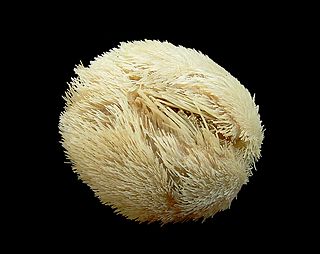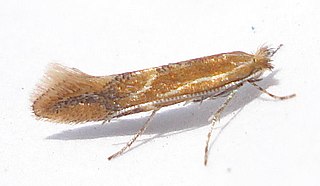Related Research Articles

Priapulida, sometimes referred to as penis worms, is a phylum of unsegmented marine worms. The name of the phylum relates to the Greek god of fertility, because their general shape and their extensible spiny introvert (eversible) proboscis may recall the shape of a human penis. They live in the mud and in comparatively shallow waters up to 90 metres (300 ft) deep. Some species show a remarkable tolerance for hydrogen sulfide and anoxia. They can be quite abundant in some areas. In an Alaskan bay as many as 85 adult individuals of Priapulus caudatus per square meter has been recorded, while the density of its larvae can be as high as 58,000 per square meter.

Perch is a common name for fish of the genus Perca, freshwater gamefish belonging to the family Percidae. The perch, of which three species occur in different geographical areas, lend their name to a large order of vertebrates: the Perciformes, from the Greek: πέρκη, simply meaning perch, and the Latin forma meaning shape. Many species of freshwater gamefish more or less resemble perch, but belong to different genera. In fact, the exclusively saltwater-dwelling red drum is often referred to as a red perch, though by definition perch are freshwater fish. Though many fish are referred to as perch as a common name, to be considered a true perch, the fish must be of the family Percidae.

Multituberculata is an extinct taxon of rodent-like allotherian mammals that existed for approximately 166 million years, the longest fossil history of any mammal lineage. They eventually declined from the late Paleocene onwards, disappearing from the known fossil record in the late Eocene, though gondwanatheres lived into the Miocene, and may have been multituberculates. More than 200 species are known, ranging from mouse-sized to beaver-sized. These species occupied a diversity of ecological niches, ranging from burrow-dwelling to squirrel-like arborealism to jerboa-like hoppers. Multituberculates are usually placed as crown mammals outside either of the two main groups of living mammals—Theria, including placentals and marsupials, and Monotremata—but closer to Theria than to monotremes. Nonetheless, at least one study found a potential status as sister taxa to monotremes/Australosphenida.

In zoological nomenclature, a type species is the species name with which the name of a genus or subgenus is considered to be permanently taxonomically associated, i.e., the species that contains the biological type specimen(s). A similar concept is used for suprageneric groups and called a type genus.

Paulo Emilio Vanzolini was a Brazilian scientist and music composer. He was best known for his samba compositions, including the famous "Ronda", "Volta por Cima", and "Boca da Noite", and for his scientific works in herpetology. He is considered one of the greatest samba composers from São Paulo. Until his death, he still conducted research at the University of São Paulo (USP).

The ashy woodswallow sometimes also called the ashy swallow-shrike is a woodswallow which is found in south Asia. Like other woodswallows, it has a short curve bill and a short square tail and long wings. It is usually seen perched in groups, high on powerlines, tall bare trees and most often in areas with a predominance of tall palm trees.
Rahmoc Enterprises is a former NASCAR Winston Cup team that operated from 1978 to 1993. The team was owned by long-time engine builder Bob Rahilly and Butch Mock. Mock left Rahmoc in 1993 to form his own team. Rahmoc Enterprises is still operating today, with Dick and Bob Rahilly still turning the wrenches, as an engine builder and supplier for many NASCAR teams. They also build racecars and manage several smaller race teams.

Loveniidae is a family of heart urchins in the order Spatangoida.

Mesostigmata is an order of mites belonging to the Parasitiformes. Unlike most members of that group, many of these mites are not parasitic but free-living and predatory. They can be recognized by the single pair of spiracles positioned laterally on the body.

The Haemosporida are an order of intraerythrocytic parasitic alveolates.

Endeostigmata is a suborder of endeostigs in the order Sarcoptiformes, which is in the class Arachnida. There are about ten families in Endeostigmata.
Narceolaelaps is a genus of mites in the family Laelapidae.
Paramegistidae is a family of mites in the order Mesostigmata.

Phyllonorycter is a genus of moths in the family Gracillariidae.

Marginellinae is a taxonomic subfamily within the larger family of Marginellidae, a group of small sea snails, marine gastropod molluscs in the superfamily Volutoidea.
Scalenodon is an extinct genus of traversodontid cynodonts from the Middle Triassic of Africa and possibly Russia. The type species S. angustifrons was named in 1946 and several other species were named in the following years. Most of the species from Africa are now thought to belong to different genera than Scalenodon.

Dileptus is a genus of unicellular ciliates in the class Litostomatea. Species of Dileptus occur in fresh and salt water, as well as mosses and soils. Most are aggressive predators equipped with long, mobile proboscides lined with toxic extrusomes, with which they stun smaller organisms before consuming them. 13 species and subspecies of Dileptus are currently recognized.

Fundulopanchax is a genus of killifish living in near-coastal fresh water streams and lakes in Western Africa. All species were previously biologically classified as members of the genus Aphyosemion, with the exception of Fundulopanchax avichang, F. gresensi and F. kamdemi, which were all scientifically described after the major revision of the Aphyosemion complex.
Syringophilidae is a family of mites, containing the following genera:

Leptaena is an extinct genus of mid-sized brachiopod that existes from the Dariwilian epoch to the Emsian epoch, though some specimens have been found in strata as late in age as the Tournasian epoch. Like some other Strophomenids, Lepteana were epifaunal, meaning they lived on top of the seafloor, not buried within it, and were suspension feeders.
References
- ↑ Joel Hallan (ed.). "Neotenogyniidae Species Listing". Biology Catalog. Texas A&M University . Retrieved September 10, 2010.